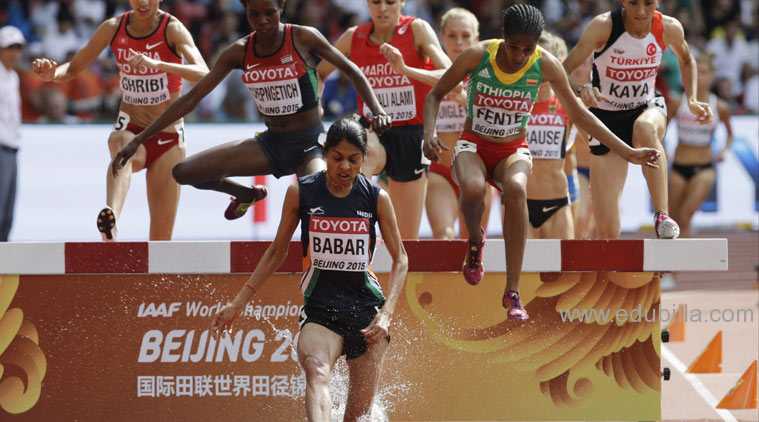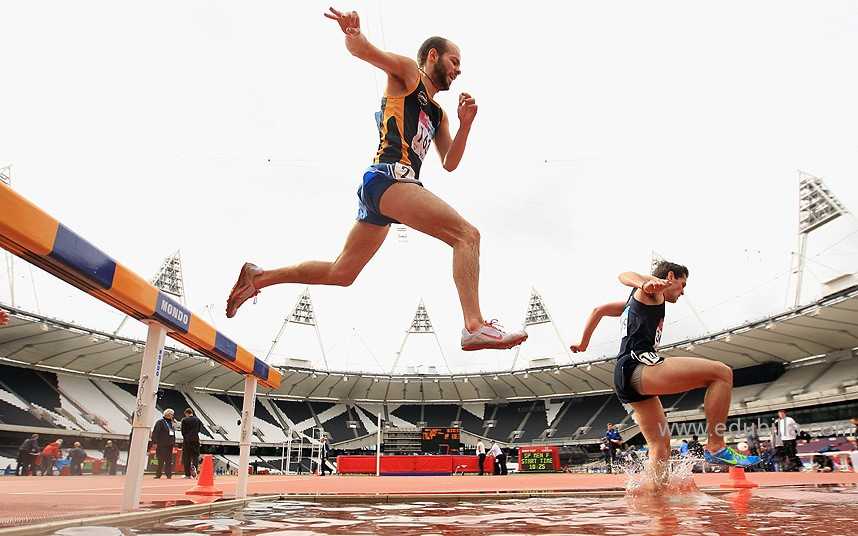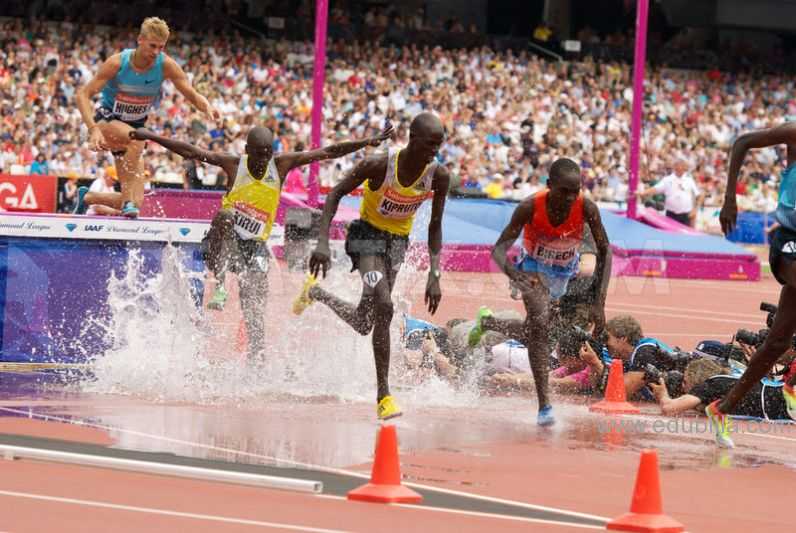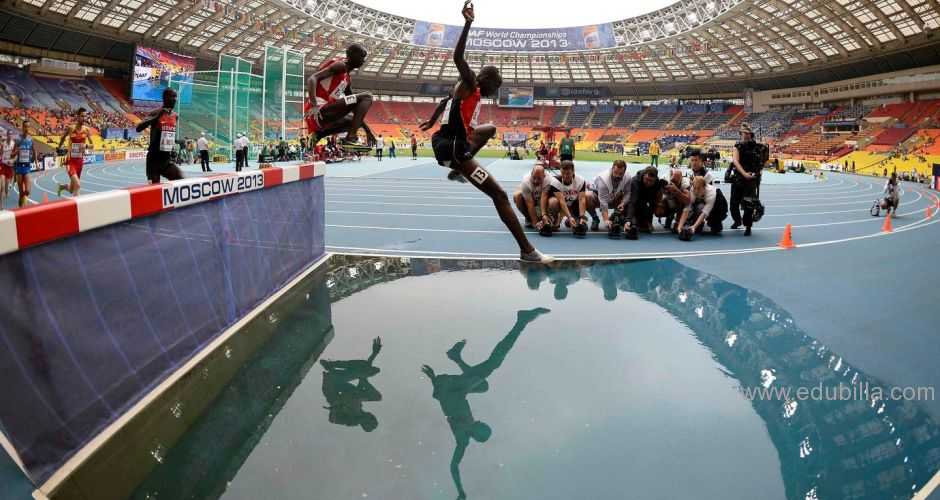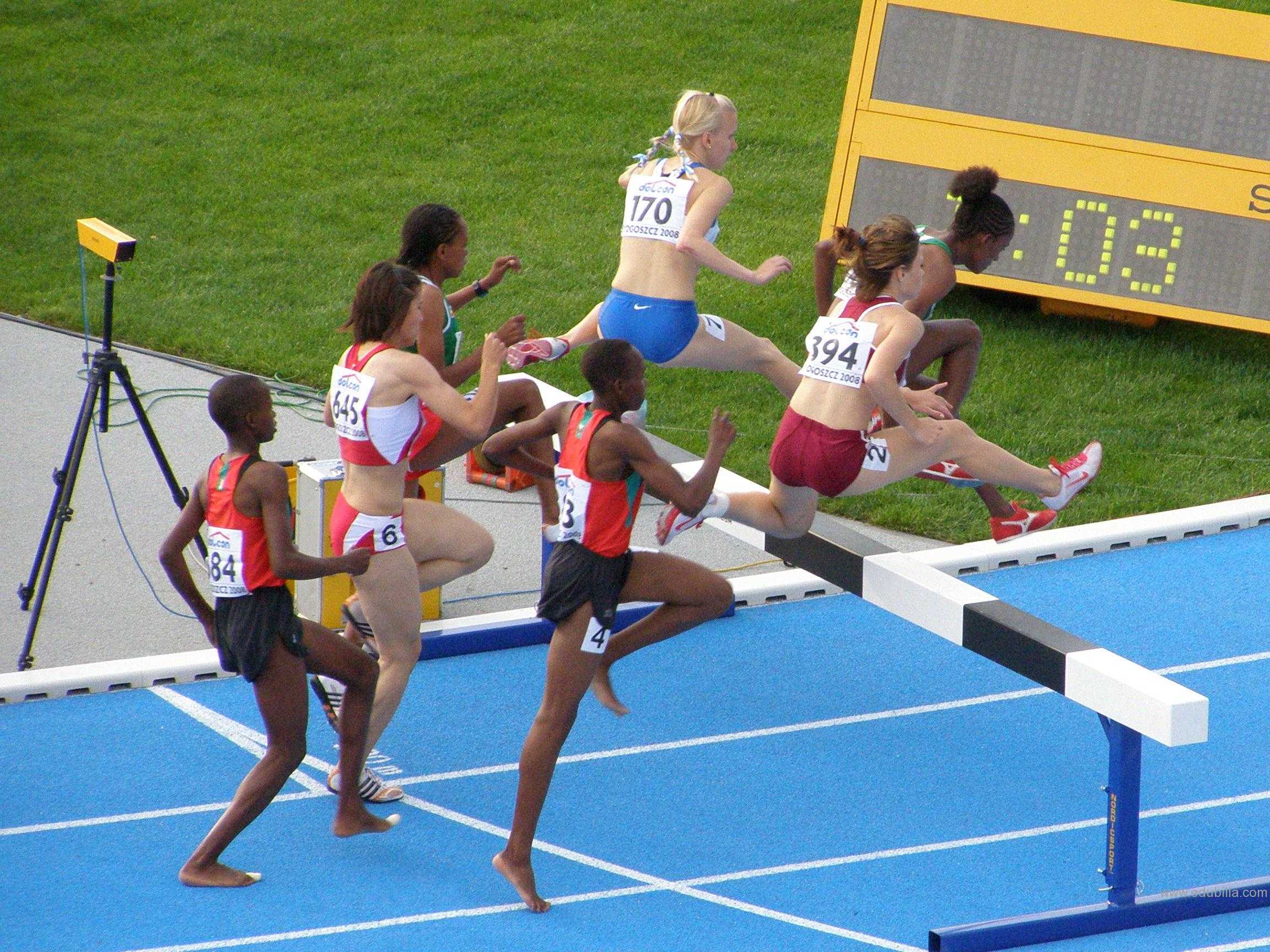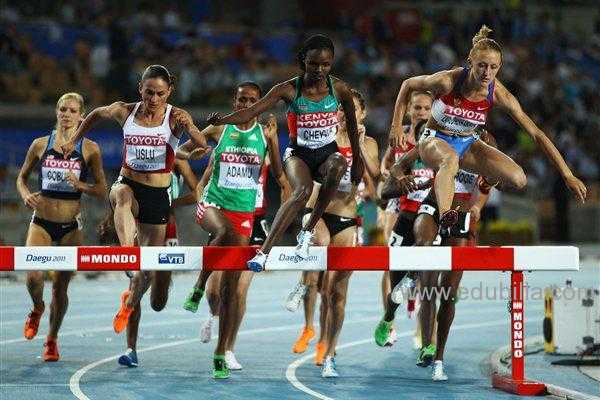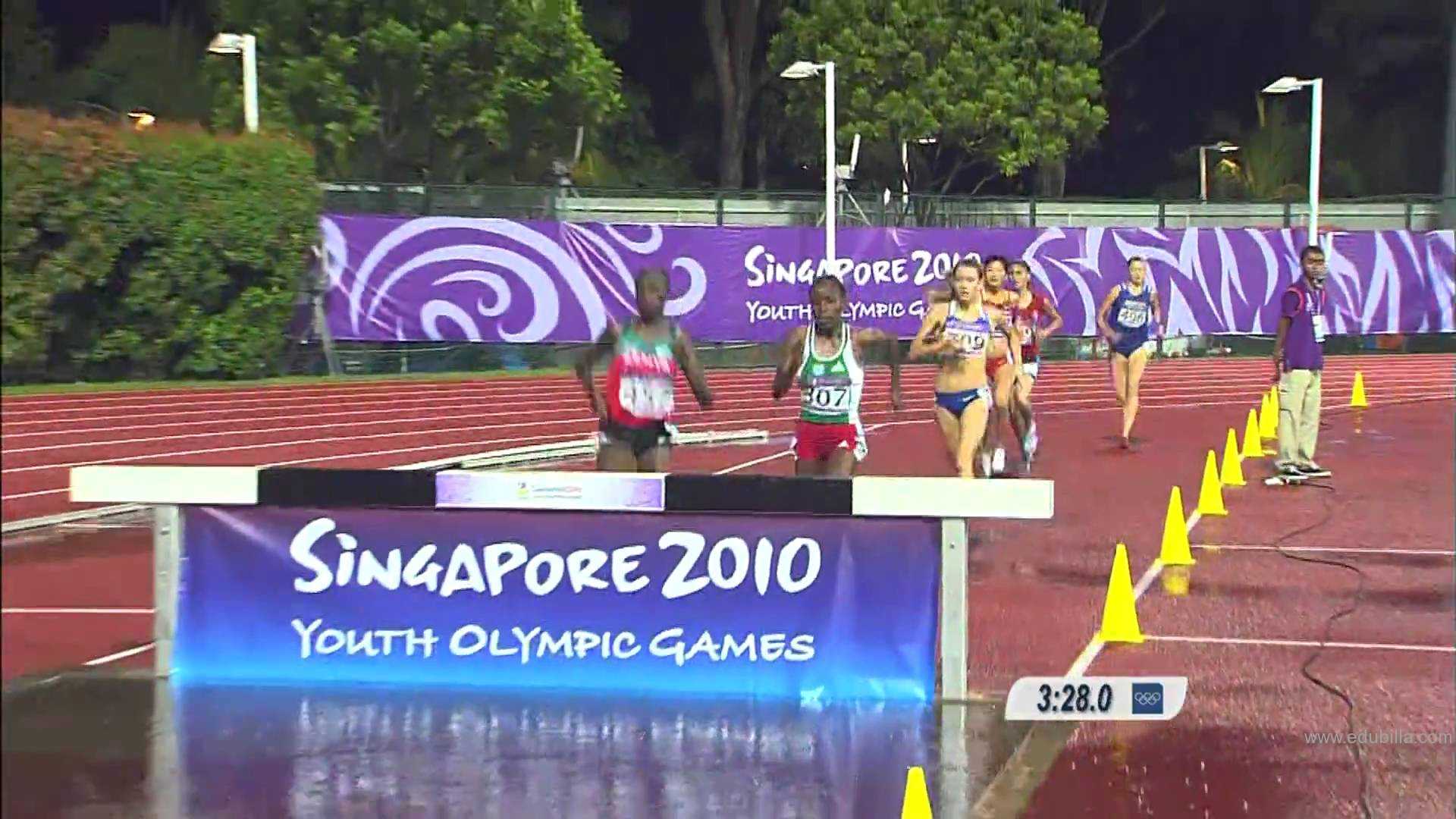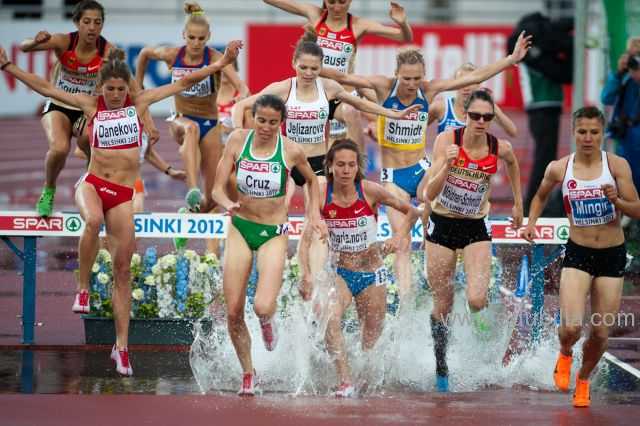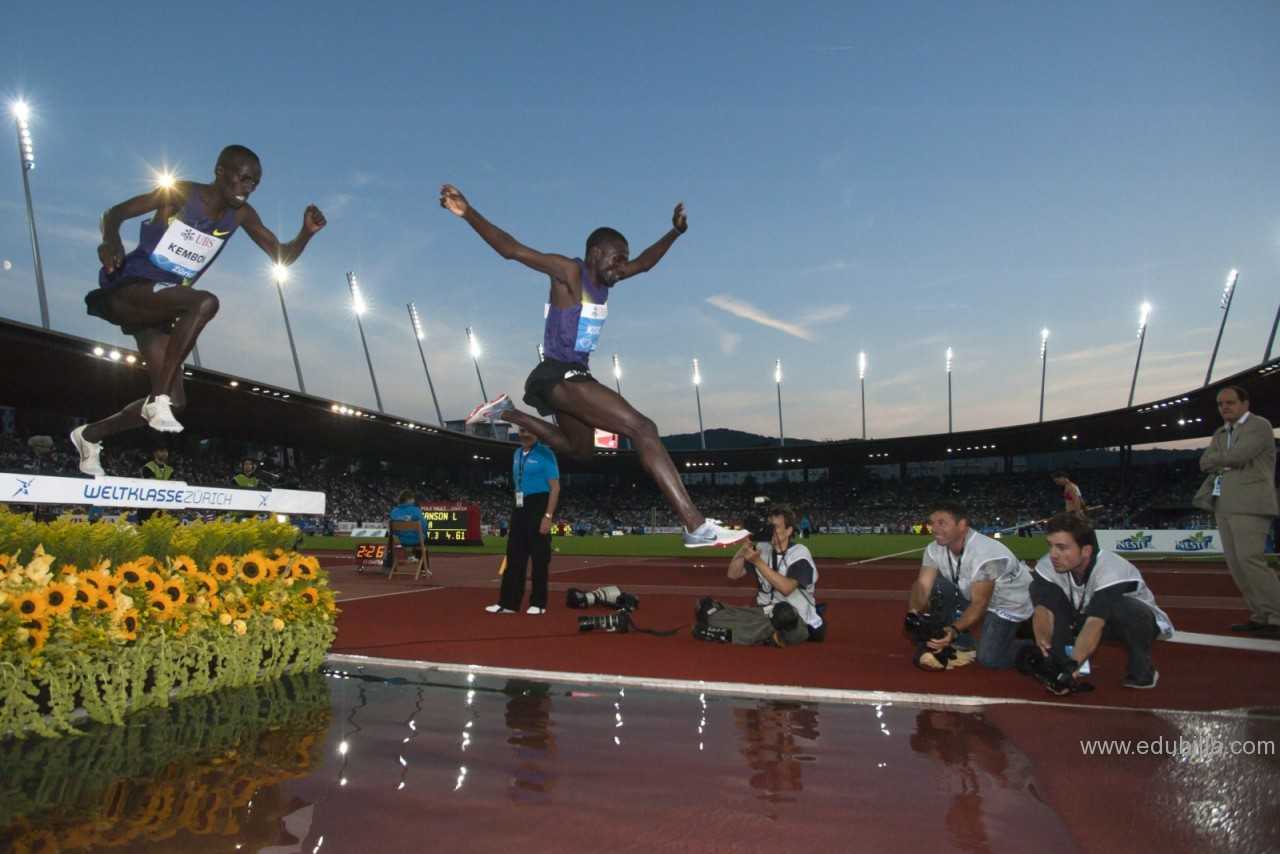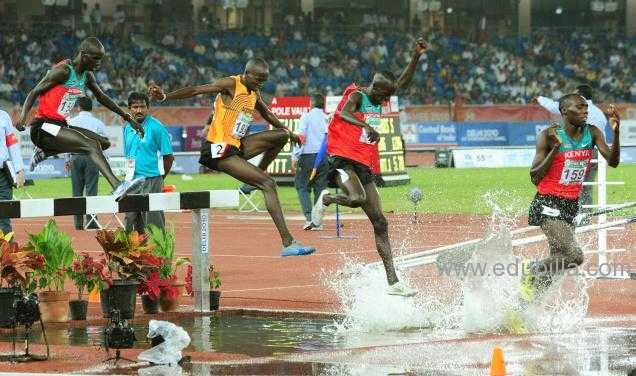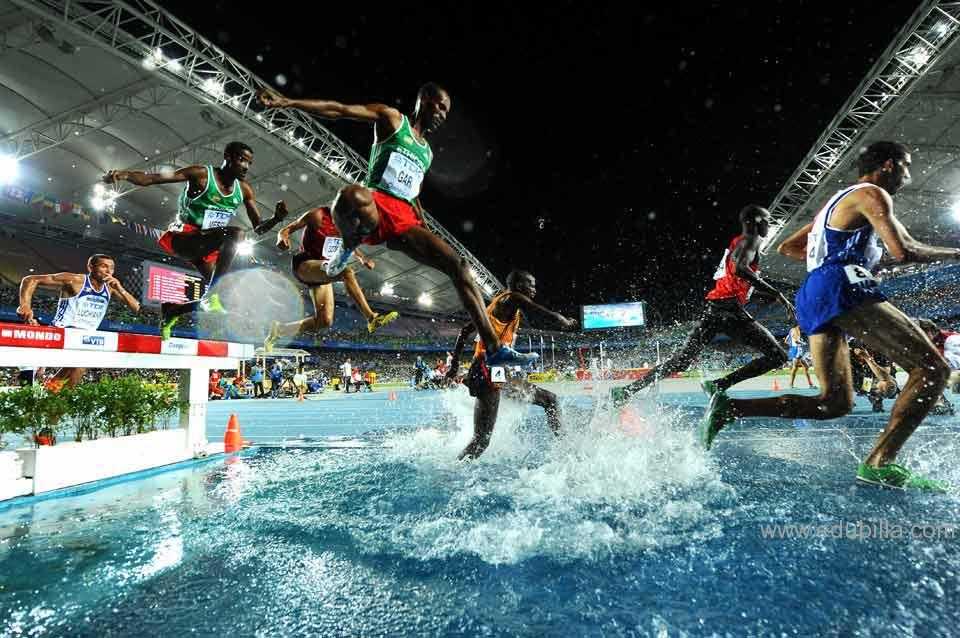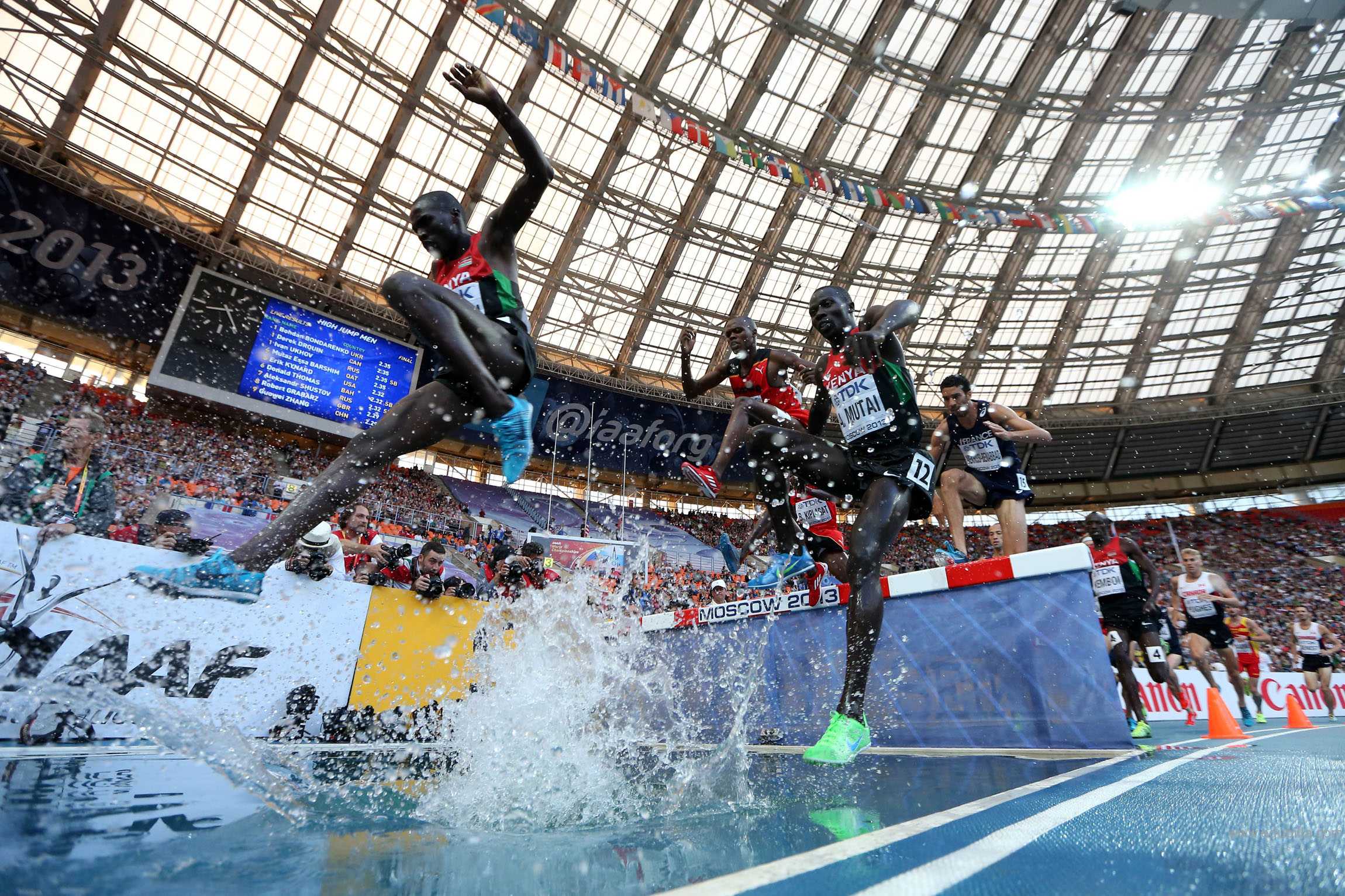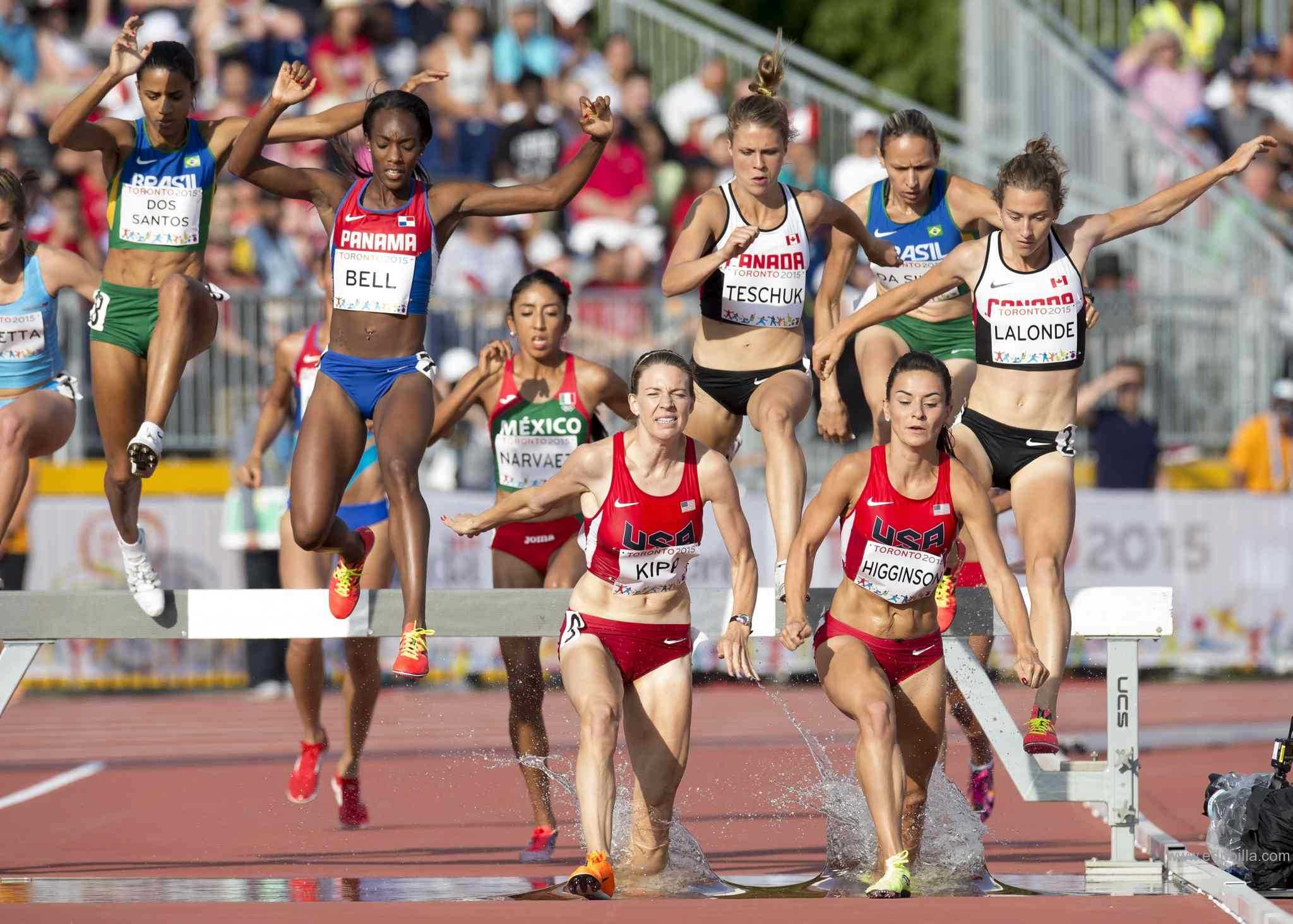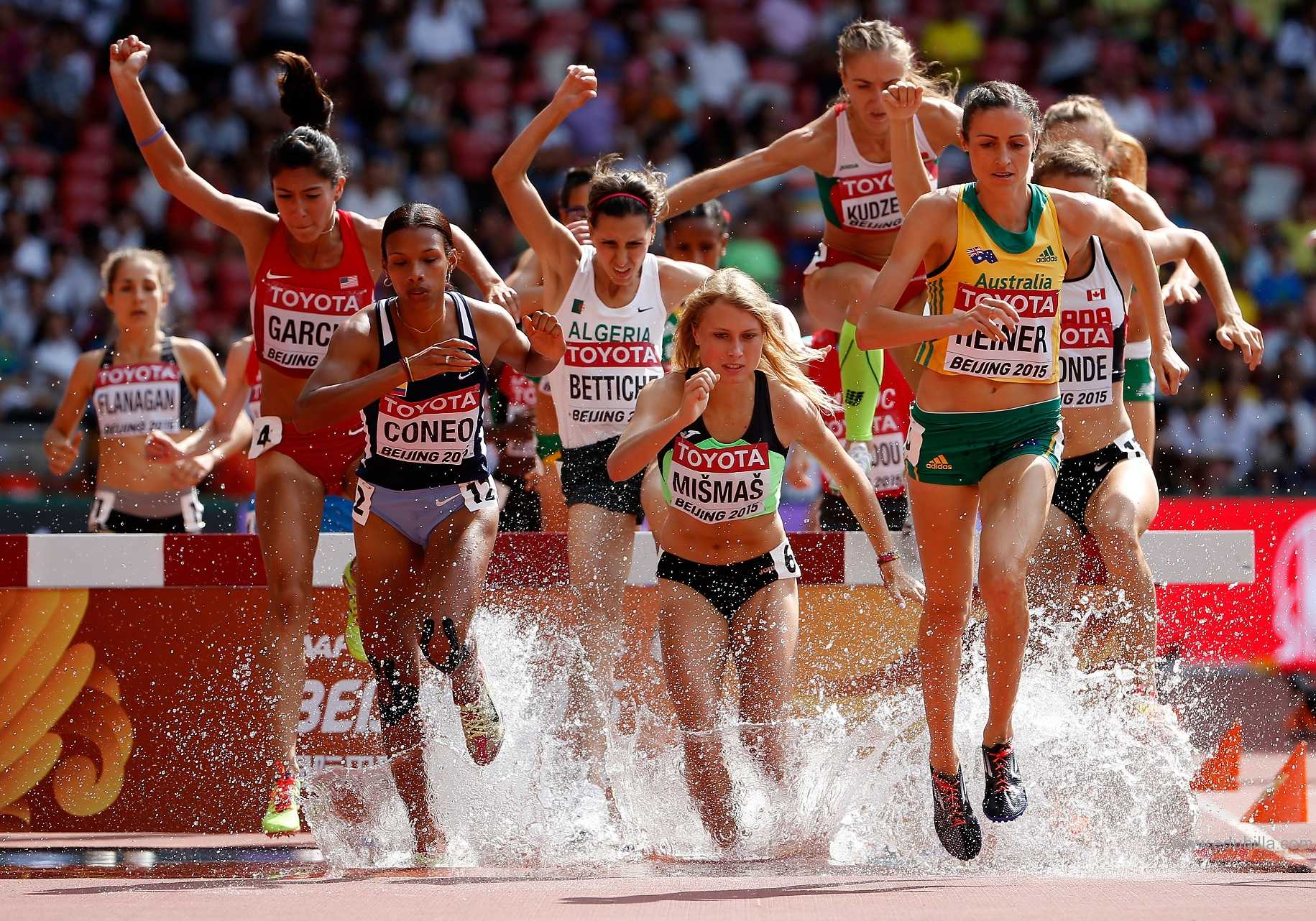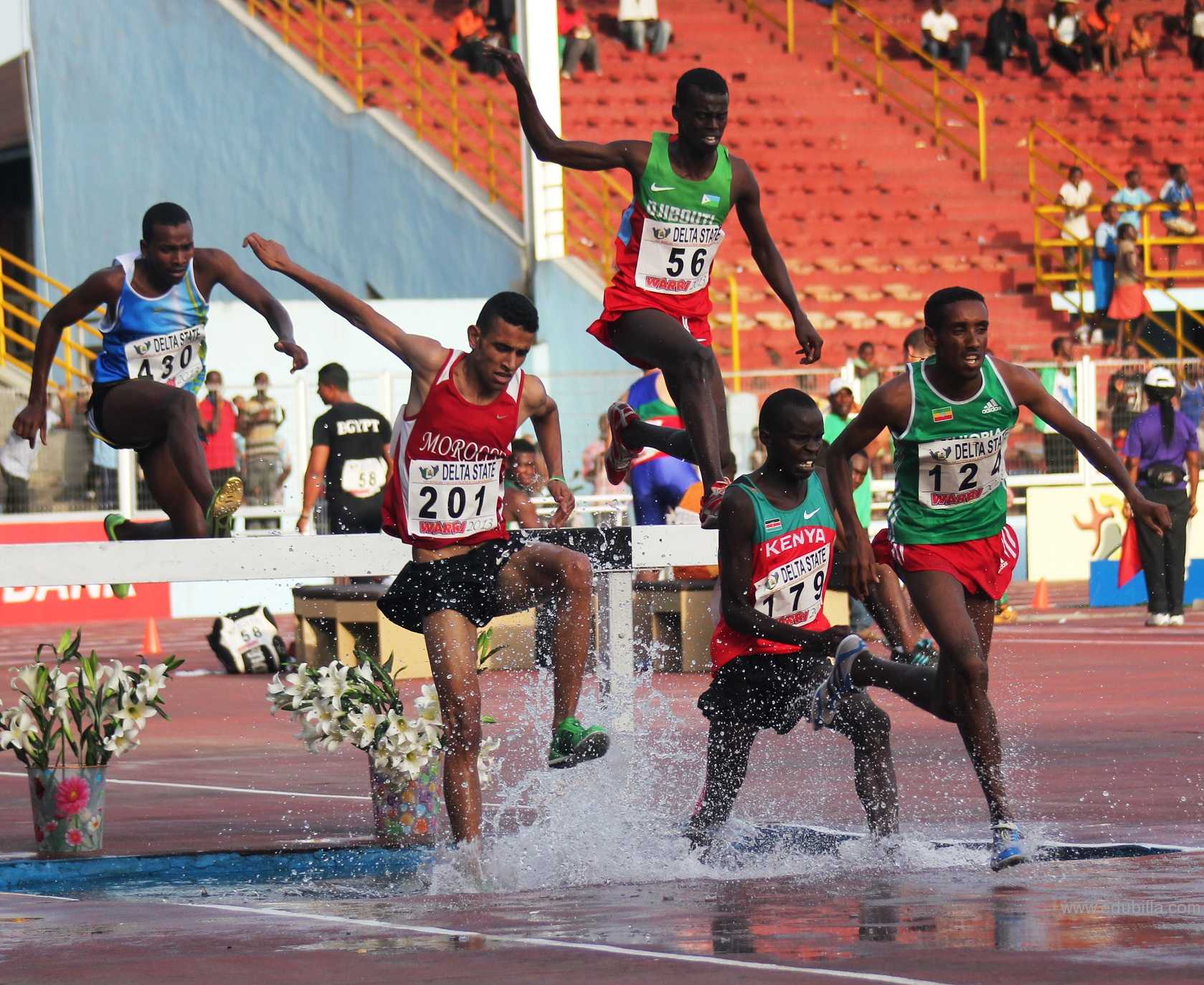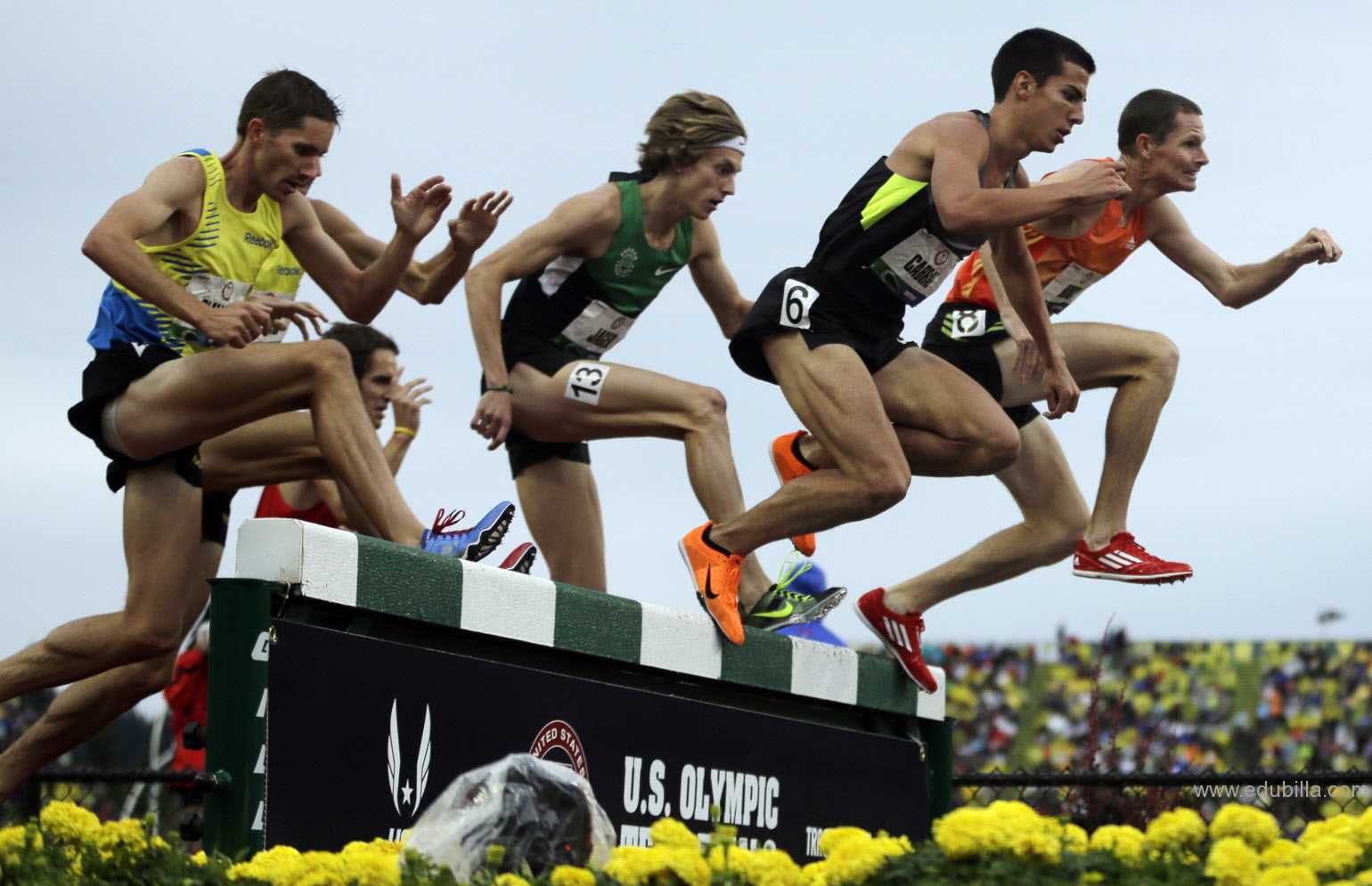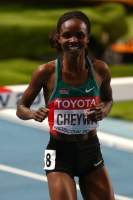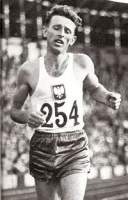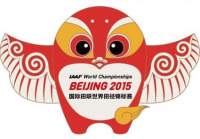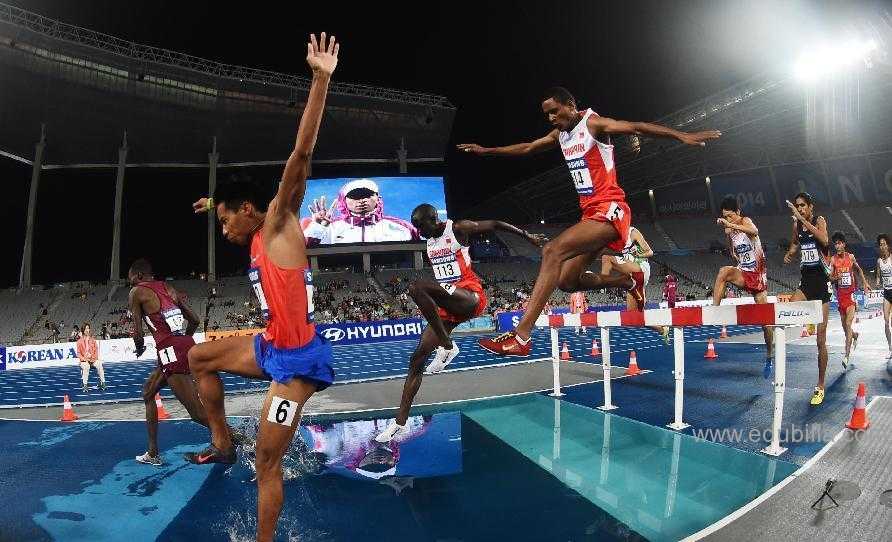
Overview Of Steeplechase (athletics)
The steeplechase is an obstacle race in athletics, which derives its name from the steeplechase in horse racing. The foremost version of the event is the 3000 metres steeplechase. The 2000 metres steeplechase is the next most common distance.
3000 metres steeplechase:
The 3000 metres steeplechase or 3000-meter steeplechase is the most common distance for the steeplechase in track and field. It is an obstacle race over the distance of the 3000 metres, which derives its name from the horse racing steeplechase.
Format:
A 3,000 metres steeplechase is defined in the rulebook as having 28 barriers and 7 water jumps. A 2,000 meters steeplechase has 18 barriers and 5 water jumps. Since the water jump is never on the track oval, a steeplechase "course" is never a perfect 400 metres lap. Instead the water jump is placed inside the turn, shortening the lap, or outside the turn, lengthening the lap. The start line moves from conventional starting areas in order to compensate for the different length of lap. When the water jump is inside, the 3,000 start line is on the backstretch (relative to the steeplechase finish). When the water jump is outside, the 3,000 start line is on the home stretch. The 2,000 start line reverses that pattern and uses 5/7 the amount of compensation.
The start:
The steeplechase begins with a standing start. The start command is, “On your marks.” Runners may not touch the ground with their hands during the start. As in all races – except those in the decathlon and heptathlon – runners are permitted one false start but are disqualified on their second false start.
The race:
The 3000-meter event includes 28 hurdle jumps and seven water jumps.The jumps begin after the runners pass the finish line for the first time. There are five jumps in each of the final seven laps, with the water jump as the fourth. The jumps are evenly distributed throughout the track. Each runner must go over or through the water pit and must jump each hurdle. As in all races, the event ends when a runner’s torso (not the head, arm or leg) crosses the finish line.?
Game Rules
- It is one of the track events in the Olympic Games and the World Championships in Athletics; it is also an event recognized by the International Association of Athletics Federations (IAAF).
- The obstacles for the men are 914 millimetres (36.0 in) high, and for the women 762 millimetres (30.0 in).
- The water jump consists of a barrier followed by a pit of water with a landing area 3.66 metres (12.0 ft) wide × 0.70 metres (2.3 ft). It then slopes upward from 700 millimetres (28 in) deep to level with the surface of the track.
- The length of the race is usually 3,000 metres (9,800 ft); junior and some masters events are 2,000 metres (6,600 ft), as women's events formerly were. The circuit has four ordinary barriers and one water jump.
- Over 3,000 metres (9,800 ft), each runner must clear a total of 28 ordinary barriers and seven water jumps. This entails seven complete laps after starting with a fraction of a lap run without barriers.
- The water jump is located on the back turn, either inside the inner lane or outside the outer lane. If it is on the outside, then each of the seven laps is longer than the standard 400 m, and the starting point is on the home straight. I
- f the water jump is on the inside, each lap is shorter than 400 m, the starting point is on the back straight, so the water jump and barrier in the home straight are bypassed in the first half lap at the start.
- Unlike those used in hurdling, steeplechase barriers do not fall over if hit, and rules allow an athlete to negotiate the barrier by any means, so many runners step on top of them.
- Four barriers are spaced around the track on level ground, and a fifth barrier at the top of the second turn (fourth barrier in a complete lap from the finish line) is the water jump.
- The slope of the water jump rewards runners with more jumping ability, because a longer jump results in a shallower landing in the water.
Detailed Steeplechase (athletics) Rules Can Be Downloaded From Documents
Equipments Need For Steeplechase (athletics)
Running shoes:
Crampons in the front of the shoes are shorter making it easier to clear the steeples. Reinforced heels are used to soften the impact of the landing.
Steeplechase Barriers:
The barrier beam is 4” x 4” square steel tubing covered with synthetic track material. Base legs have pull pin design for easy adjustability between three heights: 30”, 33”, and 36”. Powder coated for durable finish. Meets NCAA specifications. IAAF Certified.
History Of Steeplechase (athletics)
The event originated in Ireland. Horses and riders raced from one town's steeple to the next. The steeples were used as markers due to their visibility over long distances. Along the way runners inevitably had to jump streams and low stone walls separating estates.
1860-The modern athletics event originates from a two-mile (3.2 km) cross country steeplechase that formed part of the University of Oxford sports (in which many of the modern athletics events were founded) in 1860.
1865-It was replaced in 1865 by an event over barriers on a flat field, which became the modern steeplechase.
1968-It has been an Olympic event since the inception of the modern Olympics, though with varying lengths. Since the 1968 Summer Olympics the steeplechase in the Olympics has been dominated by Kenyan athletes, including the current gold medal streak since 1984 and a clean sweep of the medals at the 1992 and 2004 Games.
2005-First major championship appearance at the 2005 World Championships in Helsinki.
2008-In 2008, women's 3,000 metres steeplechase appeared for the first time on the Olympic tracks in Beijing (see Athletics at the 2008 Summer Olympics – Women's 3000 metres steeplechase).
1932-The steeplechase at the 1932 Olympics was run over approximately 3460 metres due to a lap scoring error.
Other divisions including masters athletics and youth athletics run 2,000 metres distances. The format for a 2,000 metre steeplechase removes the first two barriers of the first lap.
Origin Of Steeplechase (athletics)
Ancient events:
Much like today, the ancient Olympic Games included a wide variety of track and field events. Such events included longer foot races, a race in armour, and a pentathlon event that consisted of the “stadium” race, long jump, discus throw, javelin throw and wrestling.
The ancient Games at Olympia began simply with foot races, only occasionally complicated by dressing the runners in infantry armour or making them carry soldiers’ shields. Today, athletics remains one of the most popular Olympic sports.
Across the globe:
Similar events were held in ancient Greece at the Isthmian, Nemean and Pythian Games. Throughout Europe, local fairs and festivals often included running, jumping and throwing events. In Ireland and Scotland, these developed into organised sets of Tailteann and Highland Games, respectively. There was also a tradition of “pedestrian” events – often with heavy betting involved – in the 18th and 19 centuries, especially in Great Britain, which normally involved walking or running races.
Female equality:
Women’s track and field athletics began at the 1928 Amsterdam Games, growing steadily to an almost identical programme to the men’s. Since women’s steeplechase was added at Beijing in 2008, the only differences are that men have an extra walk at 50km and a decathlon rather than a heptathlon.
Modern organisation:
The modern format of athletics, in which a variety of running, jumping, throwing, walking and combined events are competed at a single “meeting” or “meet”, evolved in the late 19th century, when schools and military colleges began to incorporate sports and exercise as part of education programmes. The earliest recorded meeting dates back to 1840 in Shropshire, England, but specialised championships began to thrive in the 1880s in the USA, UK, and throughout Europe, as well as in other developed nations.
Governing Bodies
International Association of Athletics Federations (IAAF):
The International Association of Athletics Federations (IAAF) is the international governing body for the sport of athletics. It was founded on 17 July 1912 as the International Amateur Athletics Federation by representatives from 17 national athletics federations at the organization's first congress in Stockholm, Sweden. Since October 1993, it has been headquartered in Monaco.
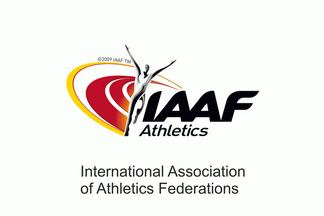
Foundation:
The process to found the IAAF was started at a meeting in Stockholm, Sweden on July 17 1912 soon after the completion of the 1912 Summer Olympics in that city. Here 27 representatives from 17 national federations agreed to meet at a congress in Germany the following year overseen by Sigfrid Edström who was to become the fledgling organisation's first president. The congress that started on August 20 1913 in Berlin is when the foundation of the IAAF was formally completed.
Qualification:
The IOC sets minimum qualifying times for each running event. Those that achieve this minimum standard, and are selected by their National Olympic Committee, compete at the Olympic Games. Track events are decided by running heats, with the top two to four athletes qualifying for the next round all the way up to the final.
Events:
Athletics can be divided into four areas: track events ranging from 100m sprints to long distance races of 10,000m; field events such as long jump, discus and javelin; road events comprising the marathons and long distance walks; and the combined events of heptathlon for women and decathlon for men.
Area Associations:
The IAAF has a total of 214 member federations divided into 6 area associations.
- AAA – Asian Athletics Association in Asia
- CAA – Confederation of African Athletics in Africa
- CONSUDATLE – Confederación Sudamericana de Atletismo in South America
- EAA – European Athletic Association in Europe
- NACACAA – North American, Central American and Caribbean Athletic Association in North America
- OAA – Oceania Athletics Association in Oceania
Awards Related To Steeplechase (athletics)
Junior Men's 3000m Steeplechase Awards - USA Track and Field Championships
UKA Coaching Awards:
Coaching Awards:
- Athletics Coach Award
- Athletics Coach Award Pre-course Material
- Athletics Coach Award Resources
- Athletics Coach Support Coach Resources
- Athletics Coach Modules - Access LEARN
- Athletics Coach Modules FAQ
- Coach in Running Fitness Award
- Coach in Running Fitness Award Pre-course Material
- Coach in Running Fitness Award Resources
- CiRF Support Coach Resources
Sample Documents Of Steeplechase (athletics)
-Sachin Tendulkar




